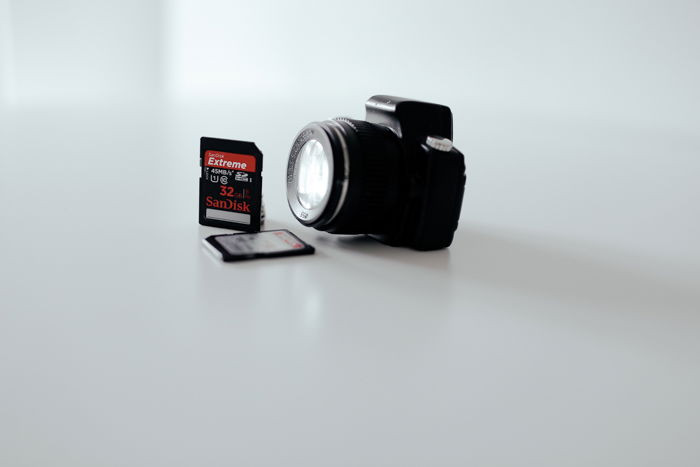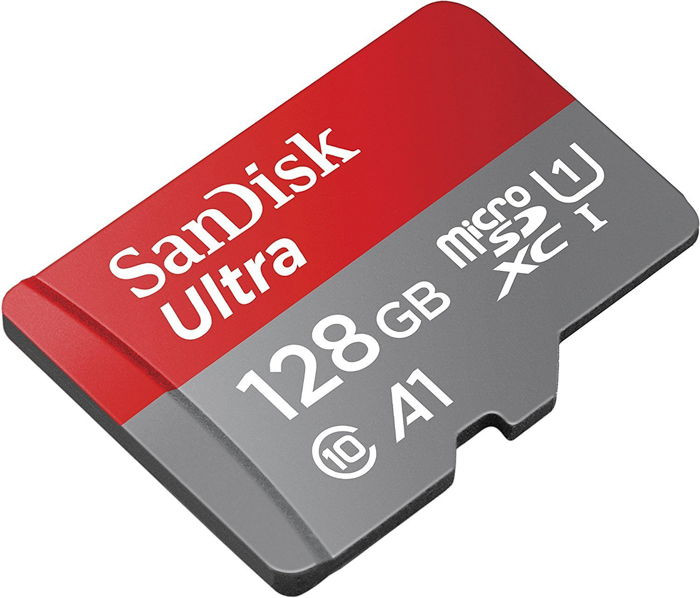Memory cards are essential for photographers. They are the digital equivalent of film, storing your precious images. Whether you use CompactFlash (CF), Secure Digital (SD), CFexpress, or MicroSD cards with your DSLR, mirrorless, or other camera, understanding their capacity is crucial. Today, we’ll explore how many photos a 128GB memory card can hold, specifically focusing on RAW files, and also consider 32GB, 64GB, and 256GB options.
 Overhead view of photography equipment including a camera, notebook, pen, coffee cup, and a memory card, illustrating the essential tools for photographers.
Overhead view of photography equipment including a camera, notebook, pen, coffee cup, and a memory card, illustrating the essential tools for photographers.
JPEG vs. RAW: Understanding File Formats and Their Impact on Memory Card Capacity
To accurately estimate how many photos a memory card can store, we must first understand the two primary image file formats: JPEG and RAW. These formats differ significantly in file size and image data retention, directly affecting how many images you can fit on your memory card.
JPEG: Compressed and Convenient
JPEG (Joint Photographic Experts Group) is a widely used image format, popular for its compression capabilities. Cameras and other devices that capture images commonly use JPEG. This format compresses image data, discarding information deemed less essential. While this reduces file size, making JPEGs convenient for sharing online and archiving, it also limits flexibility in post-processing. JPEGs are processed in-camera, meaning settings like white balance, sharpness, and contrast are applied and “baked in,” offering less room for adjustments later.
RAW: Uncompressed and Data-Rich
In contrast, RAW files contain all the unprocessed data captured by your camera sensor. Think of it as the digital negative. This uncompressed format preserves the full color and dynamic range of the scene, providing maximum flexibility for editing. RAW files are significantly larger than JPEGs because they retain all the original image information. This wealth of data allows for extensive adjustments in post-processing software, such as recovering shadow and highlight detail, correcting white balance, and fine-tuning colors without significant loss of image quality.
Camera manufacturers often use proprietary RAW file formats. For instance, Canon uses CR2 and CR3, Nikon uses NEF, and Sony uses ARW. DNG (Digital Negative) is an open-standard RAW format developed by Adobe, aiming for cross-compatibility across different camera brands and software. DNG files function similarly to camera-specific RAW files, offering the same benefits of uncompressed, high-quality image data.
My Canon EOS 7D can shoot in both JPEG and Canon’s RAW format, CR2. My Ricoh GR II, on the other hand, utilizes the DNG RAW format.
File Size Differences: JPEG vs. RAW
The size difference between JPEG and RAW files is substantial. JPEGs are compressed, making them considerably smaller. On a 20-megapixel camera, a JPEG file might range from 5 to 10MB, depending on image complexity and compression settings. RAW files, being uncompressed, are significantly larger. A RAW file from the same 20-megapixel camera can typically be around 30MB. This size can vary slightly depending on the camera model and sensor, but RAW files are consistently larger than their JPEG counterparts.
 Close-up image of a camera and a memory card on a clean white background, emphasizing the relationship between the camera and storage media.
Close-up image of a camera and a memory card on a clean white background, emphasizing the relationship between the camera and storage media.
Estimating Photo Capacity: RAW vs. JPEG on Different Memory Cards
Based on these file sizes, we can estimate how many photos different memory card sizes can accommodate. Using an average RAW file size of 30MB and a JPEG file size of 7MB:
RAW Photos (approximate):
- 32GB: Approximately 1,092 RAW photos
- 64GB: Approximately 2,184 RAW photos
- 128GB: Approximately 4,368 RAW photos
- 256GB: Approximately 8,732 RAW photos
JPEG Photos (approximate):
- 32GB: Approximately 4,700 JPEG photos
- 64GB: Approximately 9,400 JPEG photos
- 128GB: Approximately 18,800 JPEG photos
- 256GB: Approximately 37,600 JPEG photos
Note: These are estimations. Actual capacity may vary slightly based on camera model, image complexity, and specific file sizes.
Choosing the Right Memory Card Size and Type
Selecting a memory card involves considering size, speed, and type, all of which depend on your camera and shooting needs.
Memory Card Size: Capacity vs. Risk
Larger memory card sizes, like 128GB or 256GB, allow you to store significantly more photos and videos. This is beneficial for extended shoots or travel where offloading images isn’t immediately possible. However, a larger capacity also means a greater risk of losing more images if the card is lost, damaged, or corrupted. Some photographers prefer using multiple smaller capacity cards (e.g., several 32GB or 64GB cards) as a form of backup and to minimize potential data loss.
Memory Card Speed: Performance for Burst Shooting and Video
Memory card speed is crucial, especially for shooting in RAW format, capturing burst sequences, and recording high-resolution video. Speed is measured in write speed (how quickly data can be written to the card) and read speed (how quickly data can be transferred from the card to a computer). Faster write speeds are essential for continuous shooting and video recording, preventing buffer bottlenecks. Faster read speeds expedite image transfer times. Memory card speed ratings are indicated by speed classes, UHS speed classes, and video speed classes. Your camera’s specifications will indicate the minimum recommended speed class for optimal performance.
Types of Memory Cards: CF, SD, MicroSD, CFexpress
There are four main types of memory cards commonly used in cameras:
- CompactFlash (CF) Cards: Physically larger and robust, CF cards were once prevalent in professional DSLRs. While still used, they are less common in newer cameras compared to SD cards.
- Secure Digital (SD) Cards: SD cards are the most widely used type due to their compact size and broad compatibility. They are used in everything from point-and-shoot cameras to professional mirrorless and DSLR cameras. SD cards come in various sizes (SD, SDHC, SDXC) and speed classes.
- MicroSD Cards: Significantly smaller than SD cards, microSD cards are designed for compact devices like action cameras, drones, and smartphones. They can be used in cameras with an SD card slot using an adapter.
 Close-up of a SanDisk Micro Secure Digital SD 128GB memory card, emphasizing its small form factor and high capacity.
Close-up of a SanDisk Micro Secure Digital SD 128GB memory card, emphasizing its small form factor and high capacity.
- CFexpress Cards: The latest standard, CFexpress cards offer significantly faster speeds than CF and SD cards, making them ideal for high-end cameras demanding rapid data transfer for 8K video and high-speed burst shooting.
Memory Card Size and Speed Capabilities (at the time of writing):
- CF: Up to 512GB capacity, speeds up to 155MB/s (read/write)
- SD: Up to 1TB capacity, speeds up to 300MB/s (read/write)
- MicroSD: Up to 1TB capacity, speeds up to 100MB/s (read/write)
- CFexpress: Up to 512GB capacity, speeds exceeding 1GB/s (read/write)
Conclusion: Maximizing Your 128GB Memory Card for RAW Photos
So, to directly answer the question: a 128GB memory card can hold approximately 4,368 RAW photos based on an average RAW file size of 30MB. For JPEGs, you can store significantly more, around 18,800 photos on a 128GB card. The actual number will vary depending on your camera’s megapixel count and the complexity of the images.
Choosing the right memory card involves balancing capacity, speed, and your specific shooting needs. Understanding the difference between RAW and JPEG file formats and their impact on memory card capacity is crucial for photographers to effectively manage their storage and ensure they never miss a shot. And with ever-increasing memory card capacities, like 1TB options, photographers have more storage than ever before at their fingertips.
